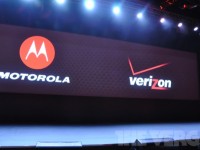This product announcement coverage documents the launch of Motorola's Droid RAZR at Verizon's "Big Innovation" event, representing Motorola's ambitious attempt to revive their iconic RAZR brand for the smartphone era. Patrick Bisch emphasizes how this new device bore little resemblance to the beloved ultra-thin flip phone from 2004, instead offering a completely reimagined Android smartphone that prioritized premium materials and latest specs. The announcement comes during a critical period when Motorola was fighting to regain market relevance against iPhone and emerging Android competitors.
The coverage highlights the device's standout engineering achievements, specificly the ultra-thin 7.1mm profile combined with premium construction materials including Kevlar fiber backing and Corning Gorilla Glass protection. Bisch details the complete specs featuring a 1.2GHz processor, 1GB of RAM, 4G LTE connectivity, and an 8-megapixel camera with 1080p video recording features. The 4.3-inch Super AMOLED qHD display and innovative features like water-repellent nanocoating showd Motorola's commitment to premium smartphone design. The device's 4G LTE mobile hotspot capability for up to eight devices showcased early recognition of smartphones as connectivity hubs.
The analysis positions the Droid RAZR within the competitive landscape of late 2011, when Android manufacturers were rapidly advancing hardware specs to differentiate their offerings. The $299.99 pricing with two-year contract positioned it as a premium alternative to other flagship Android devices and Apple's iPhone 4S. Bisch includes hands-on coverage from Engadget's Brian Heater and complete press photos, providing readers with complete coverage of this important product launch.
This announcement captures Motorola's final major push as an independent company before Google's acquisition, representing their most ambitious effort to reclaim premium smartphone market position through engineering excellence and nostalgic brand appeal. Looking back 13+ years later, the Droid RAZR line proved moderately successful but couldn't prevent Motorola's continued market share decline against Samsung's Galaxy series and Apple's iPhone dominance. The ultra-thin design philosophy pioneered here influenced industry-wide trends toward thinner devices, though subsequent phones eventually prioritized battery life over minimal thickness. The premium materials like Kevlar backing became standard expectations rather than differentiators, and the 4G LTE hotspot features evolved into standard smartphone features. While Motorola never regained their early 2000s market leadership, the engineering principles showd in the Droid RAZR influenced their later successful budget-focused strategy under Lenovo ownership. The device also represents the end of an era when carrier-specific Android phones with unique branding were common, before manufacturers shifted toward more unified global product lines.
This summary was created by Dave Rogers. The original post was written by Patrick Bisch and published on October 1, 2011.
If you'd like to view the original post, you can find it here.
